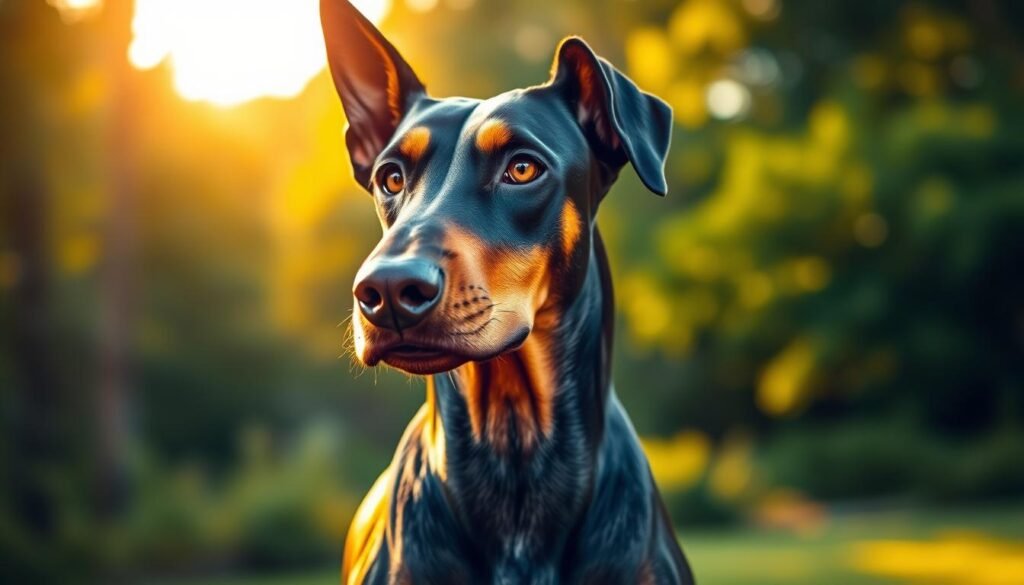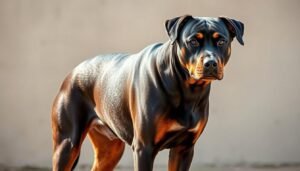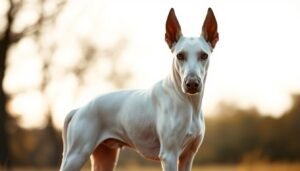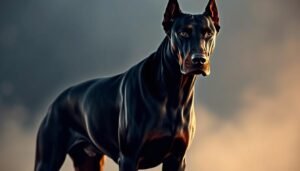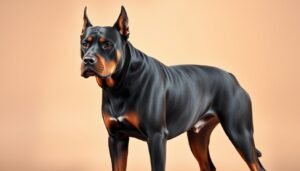I’m thrilled to share that Dobermans have some of the most beautiful colours in dogs. Their history and genetic mix make their coats very varied. You’ll see everything from sleek black to rare fawn variations. Each Doberman’s colour is special and shows its unique identity.
The breed’s colour variations are not just pretty; they’re also interesting from a genetic standpoint. Knowing about these colours can make you appreciate these loyal friends even more. This is true whether you already have a Doberman or are thinking about getting one.
Key Takeaways
- Explore the genetic basis of Doberman coat colours
- Discover the range of colours within the breed
- Learn what makes each Doberman’s colour unique
- Understand the significance of coat colour in the breed
- Enhance your appreciation for Doberman’s diverse palette
Understanding Doberman Coat Genetics
Genetics are key in figuring out Doberman coat colours. To get the full picture of Doberman dog colours, we must grasp the genetics behind their coats.
The colour of a Doberman’s coat comes from how genes work together. These genes control how melanin is made and spread. Melanin is made of two types: eumelanin and pheomelanin. Eumelanin makes black and dark brown, while pheomelanin makes red and yellow.
The Role of Genetics in Coat Colour
Doberman coat colour genetics are complex. Many genes work together to create the final coat colour. The production of eumelanin and pheomelanin is controlled by different genes. How these genes interact decides the coat colour.
For example, the gene for black coat colour is dominant. The gene for red or yellow is recessive. So, a Doberman with the dominant gene will have a black coat. One with the recessive gene will have a red or yellow coat.
Common Colour Patterns in Dobermans
Dobermans come in many coat colour patterns. These include solid, bi-colour, and patterned coats. The most common colours are black, red, blue, and fawn. These can have or not have rust markings.
| Colour Pattern | Description | Genetic Factors |
|---|---|---|
| Black and Rust | Black coat with rust markings | Dominant black gene, rust gene |
| Blue and Rust | Diluted black coat with rust markings | Dilution gene, rust gene |
| Fawn and Rust | Light brown coat with rust markings | Recessive fawn gene, rust gene |
Knowing these genetic factors helps breeders predict Doberman coat colours. This knowledge aids in making smart breeding decisions.
Classic Doberman Colours
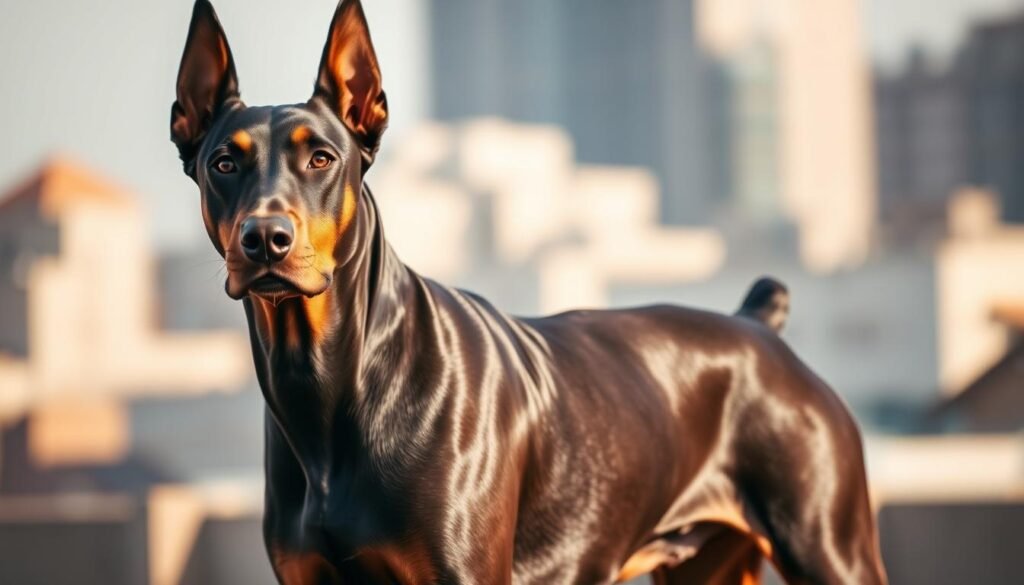
Classic Doberman colours have been a hallmark of the breed since its inception. They captivate dog enthusiasts worldwide. These timeless hues reflect the breed’s heritage, elegance, and athleticism.
Black and Rust: The Traditional Look
The black and rust Doberman is one of the most recognizable variations. It features a sleek black coat with rust-coloured markings. This creates a striking visual effect.
The contrast between the black and rust hues enhances the dog’s muscular physique. It underscores its agility and strength.
The traditional appeal of black and rust Dobermans lies in their sleek appearance. The sharp contrast of their coat colours is aesthetically pleasing. It also adheres to the breed’s historical standards.
Blue and Rust: A New Twist
In recent years, the blue and rust Doberman has gained popularity. It features a diluted black coat, often appearing as a blue-grey hue, with rust markings. This colouration gives the Doberman a distinctive and modern look.
The blue and rust variation is a result of genetic dilution. It affects the production of the black pigment, resulting in the blue appearance. Despite being less traditional, this colour is gaining recognition among Doberman enthusiasts for its unique appeal.
| Colour Variation | Description | Popularity |
|---|---|---|
| Black and Rust | Sleek black coat with rust markings | High |
| Blue and Rust | Diluted black (blue-grey) coat with rust markings | Growing in popularity |
Both the black and rust and blue and rust Dobermans embody the breed’s classic colours. Each has its unique charm. Whether you’re drawn to the traditional black and rust or the modern twist of blue and rust, these classic Doberman colours continue to captivate dog lovers around the world.
Rare Doberman Colours
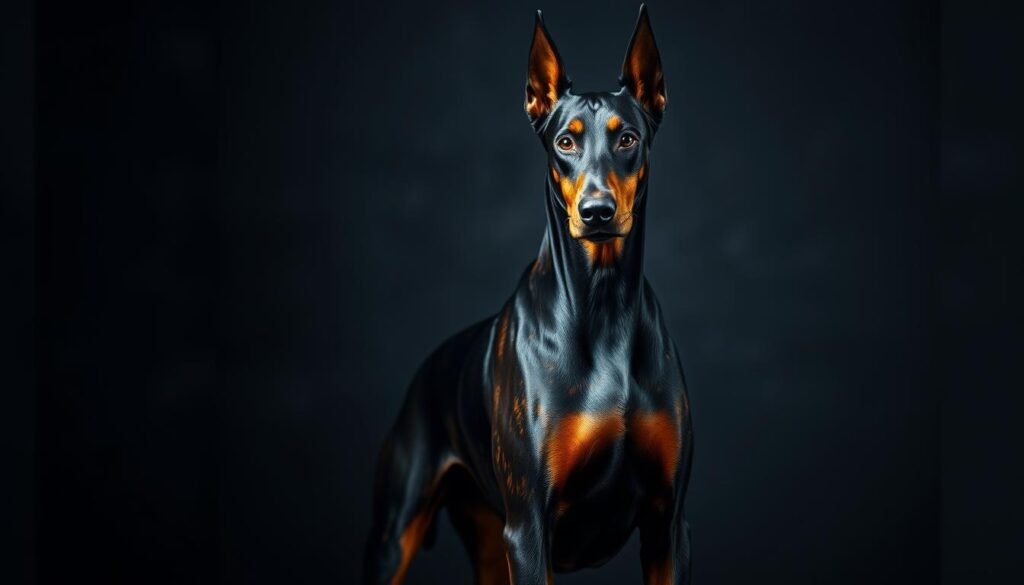
Rare Doberman colours, such as fawn and rust or Isabella and rust, are becoming more popular. These unique colours give owners a chance to have a truly special pet.
Fawn and Rust: Uncommon Yet Striking
The fawn and rust Doberman has a light tan coat with rust markings. This makes for a beautiful and unique look.
Characteristics of Fawn and Rust Dobermans:
- Light tan coat
- Rust markings
- Unique appearance
Isabella and Rust: A Unique Variation
The Isabella and rust Doberman, also known as the “fawn dilute,” is another rare colour. It has a special genetic makeup that gives it a diluted coat colour.
| Colour Variation | Coat Description | Markings |
|---|---|---|
| Fawn and Rust | Light tan | Rust |
| Isabella and Rust | Diluted fawn | Rust |
In conclusion, rare Doberman colours like fawn and rust or Isabella and rust are special. They offer a unique appeal for those seeking a distinctive pet. Knowing about these colours helps potential owners make a better choice.
Understanding the Importance of Colour
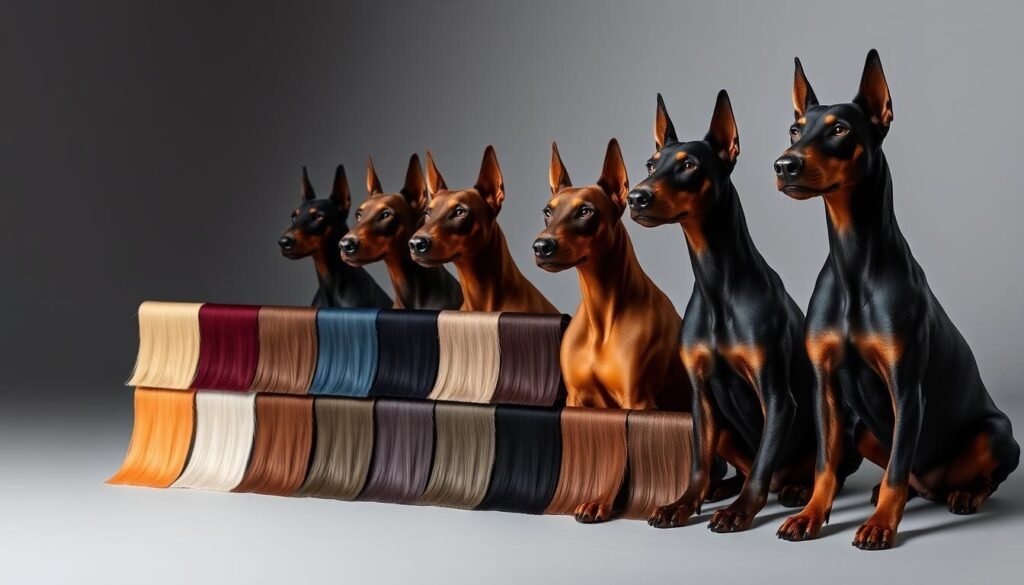
Colour is key in the Doberman world. It shapes breed standards and how owners see them. The role of colour in breeding and the breed’s identity is huge.
Colour and Breed Standards
Breed standards for Dobermans highlight certain colours. Knowing these standards is vital for breeders. Traditional colours like black and rust are highly valued, but other colours such as blue, fawn, and Isabella are also recognized.
The American Kennel Club (AKC) and other clubs have strict colour rules for Dobermans. This strict adherence to specific colours ensures the breed’s integrity and consistency.
How Colour Affects Perception
The colour of a Doberman can change how people see it. For example, a rare colour like Isabella might get more attention. But, remember, colour doesn’t change a Doberman’s temperament or quality.
“A Doberman’s colour may catch the eye, but it’s the dog’s personality and training that win hearts.” – Doberman Enthusiast
Owner perception is shaped by personal and cultural preferences. Some like traditional colours, while others enjoy the uniqueness of rarer ones. Colour’s importance lies in its role in breeding and the breed’s look.
Temperament and Coat Colour
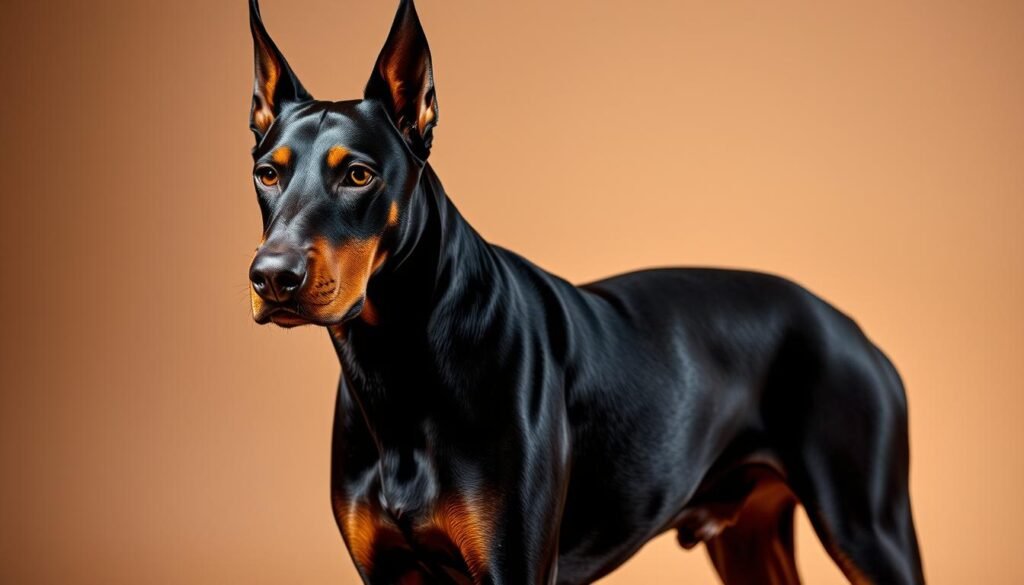
Many think a Doberman’s coat colour affects its personality. But is this true? A Doberman’s temperament comes from many things, like genes, environment, and training.
Does Colour Influence Personality?
Experts say a Doberman’s coat colour doesn’t really change its personality. A study found that genes for coat colour and temperament are different. For more on Doberman colours and types, check out Doberman Planet.
Temperament is shaped by genetics, socialization, and training. Coat colour is important for looks, but not for personality or behaviour.
Common Misconceptions About Behaviour
There are wrong ideas about Doberman coat colours and behaviour. Some think certain colours mean certain traits. But science doesn’t back these up.
| Coat Colour | Common Misconception | Reality |
|---|---|---|
| Black | Aggressive | Loyal and intelligent |
| Blue | Timid | Confident with proper training |
| Fawn | Weak | Strong and athletic |
Knowing coat colour doesn’t mean behaviour helps us see our Doberman’s true self. We can improve their temperament with the right training and socialization.
Health Considerations Linked to Colour
Doberman coat colours vary widely, and certain colours can be associated with specific health considerations. As a responsible dog owner or enthusiast, understanding these health implications is crucial for providing the best possible care for your Doberman.
Health Issues Associated with Rare Colours
Rare Doberman colours, such as Isabella and fawn, can sometimes be linked to specific health issues. This is because the genetics involved in their coat colour production can affect their health. For example, the dilution gene responsible for these colours can lead to Color Dilution Alopecia. This condition causes hair loss and skin problems.
It’s essential to be aware of these potential health concerns when considering a Doberman with a rare coat colour. Regular veterinary check-ups and genetic testing can help identify any issues early on. This ensures your dog receives the necessary care.
Color-Related Genetic Disorders
Certain genetic disorders can be more prevalent in Dobermans with specific coat colours. For example, Dobermans with the blue coat colour can be prone to skin allergies and conditions. This is due to the genetic factors that dilute the black pigment to blue.
| Coat Colour | Associated Health Issue | Prevention/ Management |
|---|---|---|
| Isabella | Color Dilution Alopecia | Regular grooming, genetic testing |
| Blue | Skin allergies | Protective grooming, allergy management |
| Fawn | Skin conditions | Regular veterinary check-ups, proper skin care |
Understanding these color-related genetic disorders can help you make informed decisions about your Doberman’s health. By being aware of the potential issues associated with their coat colour, you can take proactive steps to ensure their well-being.
Grooming Doberman Coats for Different Colours
Grooming is key for Doberman care. Knowing what each coat colour needs is important. A clean Doberman looks better and stays healthier.
All Dobermans need regular grooming. Brushing their coat often removes dead hair and spreads skin oils. This keeps their coat shiny and healthy.
General Grooming Tips for Dobermans
To keep your Doberman’s coat looking great, follow these tips:
- Regular Brushing: Brush your Doberman at least once a week. This removes loose hair and spreads skin oils.
- Bathing: Bathe your Doberman every 2-3 months, or more if needed. Use a mild dog shampoo that fits their coat type.
- Nail Care: Trim your Doberman’s nails often. This prevents them from getting too long and causing problems.
- Ear Cleaning: Clean your Doberman’s ears weekly. This stops wax buildup and infections.
Special Care for Rare Colours
Dobermans with rare colours like Isabella or fawn need extra care. Here’s what to do:
| Coat Colour | Special Care |
|---|---|
| Isabella | Use a colour-protecting shampoo to keep the unique hue. Regular conditioning is also crucial to prevent dryness. |
| Fawn | Regular brushing is essential to prevent matting. Use a gentle brush to avoid damaging the coat. |
By following these grooming tips and understanding your Doberman’s coat colour needs, you can keep their coat healthy, shiny, and vibrant.
Training Dobermans: Influence of Colour
The colour of a Doberman’s coat can subtly affect its training. While the breed’s temperament is key, the coat colour also plays a role. It can influence how a dog is seen and how it reacts to training.
Identifying Colour Preferences During Training
When training a Doberman, consider if coat colour affects training responses. Some think dogs with certain colours might react better to specific cues. For example, a black and rust Doberman might do well with dark aids, while a fawn Doberman might get distracted by light objects.
To find out colour preferences, try different coloured training aids. Watch how your dog reacts. This can help you tailor training to your dog’s needs, making sessions more effective.
Colour-Coded Training Techniques
Colour-coded training uses colours to mean specific commands. For instance, use a red ball for “stop” and a green ball for “go”. This is great for Dobermans, who are visual learners.
To use colour-coded training, pick distinct colours your dog can tell apart. Use these colours consistently in training. Your Doberman will learn to link colours with actions, making training more fun and efficient.
Using colour in training makes it more engaging and effective for Dobermans. Whether you’re teaching basic commands or advanced agility, colour-coded techniques can help you reach your goals.
Choosing the Right Doberman Colour for You
Choosing a Doberman is more than just the colour. The coat colour is important, but it’s not everything. You should think about what kind of companion you need, not just how they look.
Factors to Consider Beyond Colour
There are many things to think about before picking a Doberman. Their temperament, health, and how they fit into your life are key. A Doberman’s personality can greatly affect your daily routine, whether you’re busy or have a big family.
Also, some colours might have health issues. Knowing about these health concerns is important.
Making an Informed Decision
To make a good choice, learn as much as you can about Dobermans. Understand the breed standards, grooming needs, and how training works with different colours and temperaments.
By looking at all aspects, you’ll find a Doberman that looks good and fits well with your life.
- Research the breed standards and colour genetics.
- Consider your lifestyle and how a Doberman fits into it.
- Understand the health and grooming needs associated with different colours.
Prominent Doberman Colour Examples
The variety of Doberman colours is amazing. It has caught the eye of dog lovers all over the world. Looking at famous Dobermans in different colours helps us appreciate their special traits.
Famous Dobermans in Various Colours
Some Dobermans have become famous because of their colours. For example, Zeus, a black and rust Doberman, is well-known online for his speed and good looks. Rocky, a blue Doberman, is famous for his unique colour and friendly nature.
Doberman Colour Inspiration from Social Media
Social media is full of Dobermans in various colours. You can see everything from fawn and rust to Isabella and rust. These dogs inspire many with their beauty and charm. Looking at these examples helps us understand the beauty of each colour.

